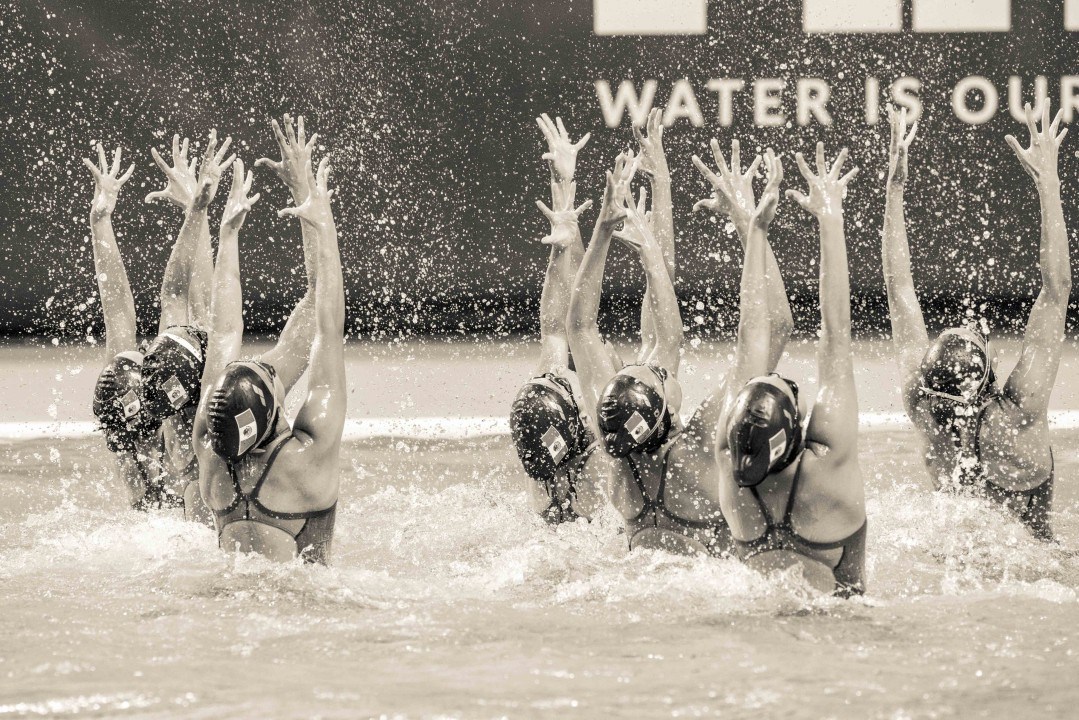SwimSwam welcomes reader submissions about all topics aquatic, and if it’s well-written and well-thought, we might just post it under our “Shouts from the Stands” series. We don’t necessarily endorse the content of the Shouts from the Stands posts, and the opinions remain those of their authors. If you have thoughts to share, please [email protected].
This “Shouts from the Stands” submission comes from Jessica Hubler
Is synchronized swimming really a sport? Despite the doubt of many people, synchronized swimming is one of the most underrated but most difficult sports, and it certainly deserves to be in the Olympic games.
Olympic synchronized swimmers train for as long as eight hours a day, for six days a week− much longer than most other Olympic sports. The athletes are not just in the water the whole time, they spend hours stretching, doing Pilates, strength conditioning, diligently training, lifting weights, performing ballet, and even dancing and doing gymnastics. Because of this, synchronized swimmers are some of the strongest and well-rounded athletes to compete in the modern Olympic games.
In synchronized swimming, the performance isn’t all about being able to complete a number of movements in order, although that’s still a large part of it. Synchronized swimmers must perform many movements and positions called figures while managing their breathing and coordination with the swimmers around them. To increase their lung capacity, often times synchronized swimmers will do exercises called “unders” during practices. They will swim a 25 meter lap underwater, repeating this exercise over and over until they’re beyond exhausted. This exercise is completely necessary for synchronized swimmers to master, because more than half of a routine is performed underwater.
To achieve perfect synchronization with those around them, synchronized swimmers must count in their head and at the same pace as everyone else. In order to practice this, the team will “land drill” the routine. “Land drilling” is exactly what it sounds like: going through the routine… on land. They use specific arm movements and positioning to block out the figures, since they are without the weightlessness of the water. However, they must practice the routine hundreds of times in order to get a feel for the water and perfectly synchronize an average team of eight people in one three-minute-performance.
Although synchronized swimming is a very graceful and beautiful sport, there can be some dangers. The synchronized swimmers can’t touch the bottom of the pool in a routine, or they’ll be disqualified. They must continuously move their legs in circular movements, like an egg-beater. Because synchronized swimming is a contact sport and the swimmer’s kicks are so powerful, swimmers may get hit by other competitors’ legs, causing concussions or knocking off nose clips, which is an essential piece of equipment. A nose clip keeps air from escaping out one’s nose as they perform figures and routines upside down. Since it’s fairly common for a nose clip to get knocked off, many times swimmers will swim with a couple extras.
In a competition, swimmers are judged and scored separately on the figures they must complete. For this reason, the swimmers must work incredibly hard to perfect their movements and positions in the water. These scores are then averaged and added into the scores for their routines.
Synchronized swimming is practiced all around the world, making the Olympics the perfect place for the best of the best to compete against each other in order to bring glory to their country. Synchronized swimming is one of the most intense, strenuous, and difficult sports to perfect, making it an Olympic sport that shouldn’t be underestimated.
Jessica Hubler is a ninth grader in Pennsylvania who enjoys
English and writing. She hopes to either have a career in Journalism or writing someday. Jessica is on both a competitive and recreational synchronized swimming team at a nearby high school. She enjoys playing piano, being part of a robotics team at school, and especially swimming.

I really did learn alot
Jessica, I was also a synchronized swimmer when I was young. (12-15) I wish more people would realize how strenuous a sport synchronized swimming truly is. Jessica isn’t kidding when she says imagine running a race while holding your breath. Reading this article makes me think of two things. One being,
1.. 2.. 3.. 4.. 5.. 6.. 7 ..8. The neverending counting, which is how the synchronization happens A how hard it was to hold your breath, upside down doing the equivalent of gymnastics. I was surprised to read, at the end of this article, that you were only in 9th Grade! So much surprised, that I definitely see a future for you I Journalism! And BTW. Synchronized or… Read more »
Absolutely it’s a sport! Try running a 4-minute mile, the whole time holding your breath, smiling & making it look effortless!
We are athletes of the same degree as Aaron Rodgers & Lebron James!
Hard to believe that you’re only in high school. A well written piece!
The synchro girls in our area are indeed amazing athletes. They are amazing sprinters when they race on the high school swim team for fun. It’s most certainly a sport, and the most underrated one for sure.